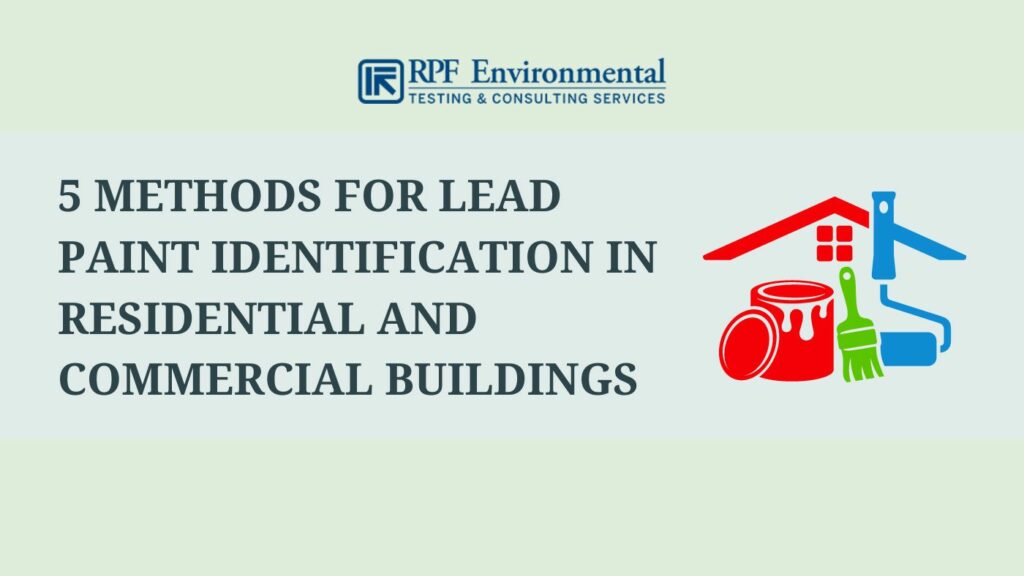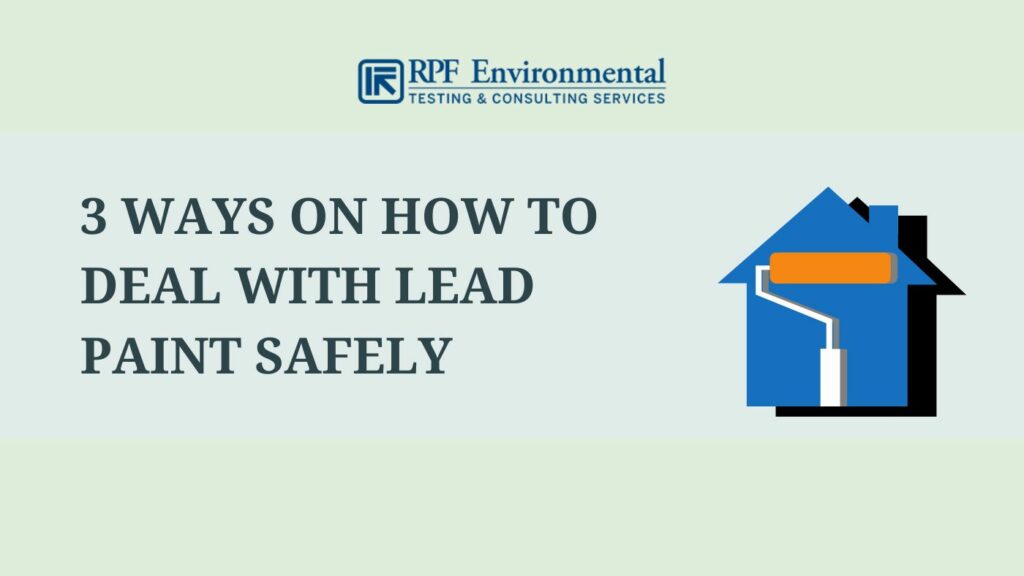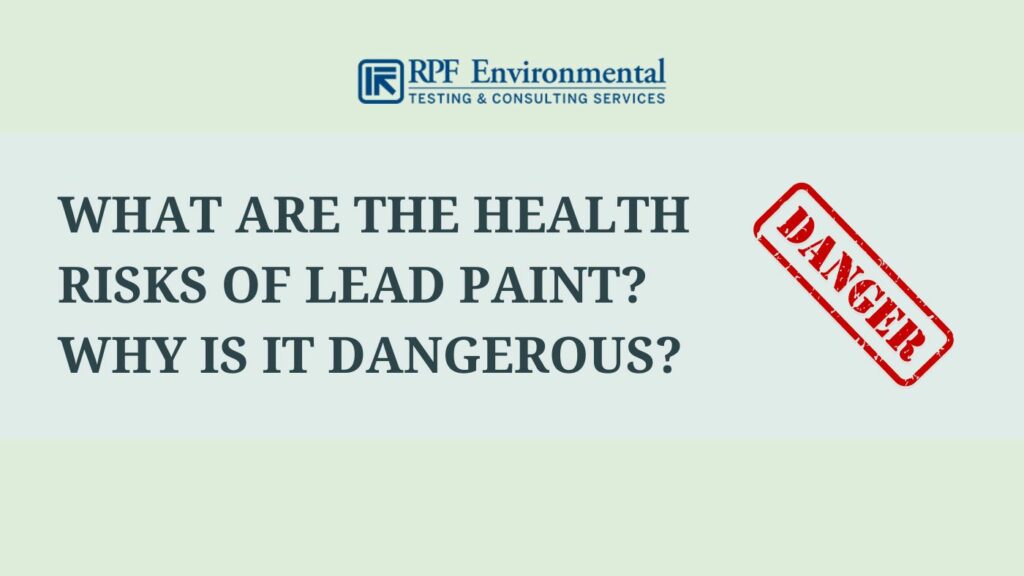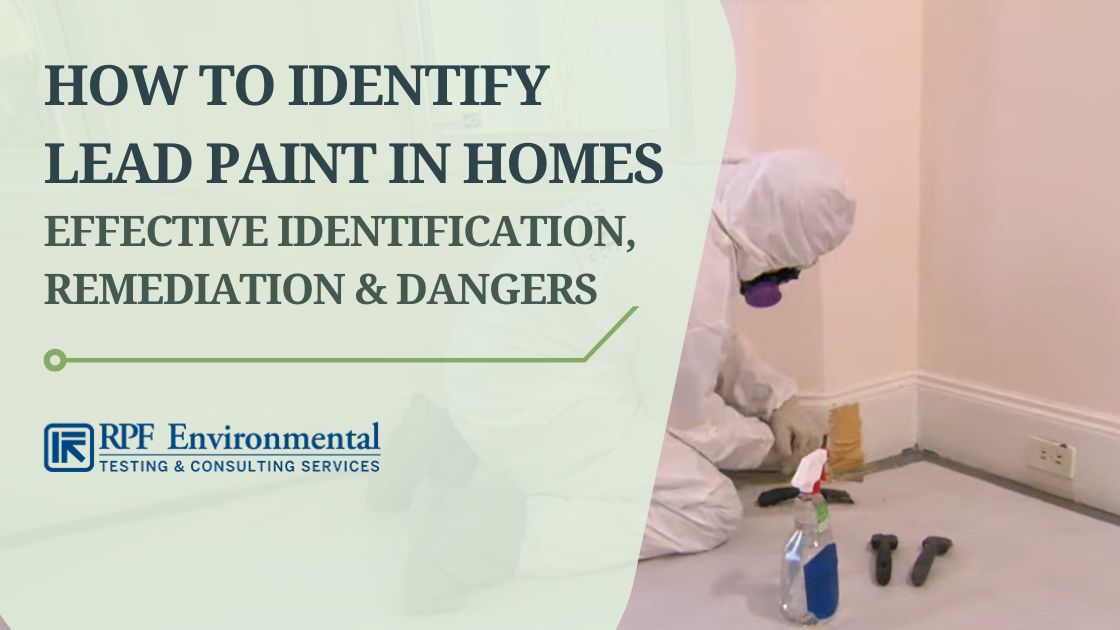Lead paint is dangerous and can cause various health problems, especially to young children and pregnant women. So if you are concerned that your home or business may have lead paint, you’ve come to the right place!
In this article, we will provide you with methods on how to identify lead paint in your home/business, how to deal with it, and its potential health risks.

RPF Environmental provides environmental testing and consulting services in Illinois, Indiana, Maine, Massachusetts, New Hampshire, and across the country. We have certified lead paint inspectors and risk assessors for effective lead paint testing. Contact us now!
What is Lead Paint?
Lead paint or lead-based paint is used to refer to any paint containing lead. The main purpose of adding lead to paint before the 1980s was for moisture resistance, increased durability, and accelerated drying. However, it was banned in the United States in 1978 for consumer use due to its significant health risks.
5 Methods for Lead Paint Identification in Residential and Commercial Buildings

To determine if you have lead paint in your home or business, we have listed 5 methods you can follow:
Method 1. Check for Symptoms of Lead Poisoning
If someone in your household is experiencing unusual symptoms and you live in an old house, lead paint might be the cause. However, take note that the symptoms of lead poisoning can manifest in different ways and can be hard to detect in the early stages. Symptoms will only become prominent after ingestion in large amounts.
Method 2. Determine When the Structure Was Built
Ask your landlord or the previous owner or seller (if you bought your house) regarding the construction date of the structure. The Lead-Based Paint Disclosure Rule requires agents, landlords, and sellers to provide certain information to renters and buyers regarding lead hazards prior to buying or renting.
Also, the EPA states that the older the house is, the higher the possibility that it has lead paint. Below are the percentages of homes with lead paint based on the year they were built:
- Before 1940: ~87%
- 1940-1959: ~69%
- 1960-1977: ~24%
However, this doesn’t mean that your home is safe from lead paint if it is built after 1978. Though the production and sale of lead paint were banned, some contractors and homeowners still continued using them afterward.
Method 3. Look Out for Possible Signs of Lead Paint
The third method is to look for lead paint hazards that include deteriorating, cracked, chalky, and multiple layers of paint:
Deteriorating Paint
Check for paint that is peeling, chipping, or flaking off.
Cracked Paint (“Alligatoring”)
Alligatoring is among the top signs of lead paint. This condition happens once the paint starts to wrinkle and crack which creates an alligator scale-like pattern. Though it is not a unique indicator of the presence of lead paint, it is a sign that the paint is old and might contain lead.
Chalking Paint
Chalking paint is also a potential source of lead dust. But take note that you can’t easily spot chalky paint if there are new layers of paint covering it. This is why we recommend checking areas that may not have been painted over like baseboards and closets.
Dampness and Bubbling
Also check areas that are often exposed to moisture like your basement or bathroom. This is because condensation and steam can cause the old paint to deteriorate over time.
Multiple Paint Layers
The last sign you should check are multiple paint layers on old homes. Previous owners of the house might have painted over the original lead-based paint during renovations. You can easily spot multiple layers of paint on deteriorating areas.
Where Should You Check for Lead Paint?
Look for signs of lead paint on surfaces that are prone to wear and tear. Moisture, impact, and friction can disturb the paint and produce lead dust which is dangerous when inhaled or ingested.
These high-risk areas include the following:
- Windows
- Window sills
- Doors
- Doorways
- Door frames
- Stairs
- Banisters
- Railings
- Porches
- Walls
- Baseboards
- Floors
- Cabinets
Method 4. Use a DIY Lead Test Kit
If you suspect the presence of lead paint in your home, consider using a DIY lead test kit. EPA-Recognized lead test kits that comply with the Lead Renovation, Repair, and Painting (RRP) Rule include the following:
- 3M™ LeadCheck™
- D-Lead®
- State of Massachusetts lead test kits
You can find more information on EPA’s page including performance criteria for DIY lead test kits.
NOTE: Lead test kits can only be used for exposed lead paints. They can’t detect lead when the original paint has been painted over.
“Consumers should exercise caution when using these lead test kits to evaluate consumer products for potential lead exposures. To test for lead-based paint in your home, EPA recommends that you hire a certified inspector or risk assessor.” – Environmental Protection Agency
Method 5. Seek the Help of a Professional Lead Paint Testing & Removal Company
The safest and most accurate way to identify lead paint in your home or business is to hire a certified company that can inspect and assess the risks. They can determine which locations have lead-based paint (usually through XRF lead testing) and evaluate the extent of the hazard. This will be helpful when you are planning to repair or renovate your home so you can follow lead-safe practices during the process.
When Should You Be Concerned About Lead Paint Exposure?
If you are living, renovating, or buying an old home built before 1978, you should be worried about potential lead paint exposure. This is especially if you have small children in your home and are starting to experience symptoms of lead poisoning which we will discuss later.
How Do You Know if Lead Paint is a Hazard in Your Home?
Well-maintained lead paint that isn’t damaged won’t usually cause danger to the health unless you find them on high-risk areas we have listed above. But if the paint starts to deteriorate, it can produce hazardous lead dust that will accumulate on surfaces like floors, windowsills, countertops, fabrics, children’s toys, and others.
3 Ways on How to Deal With Lead Paint Safely

If you have confirmed that your home has lead paint, below are three ways on how to effectively and safely handle it:
1. Encapsulation
If the lead paint is in good condition without any signs of deterioration, you can cover it with a long-lasting paint called an encapsulant. These will prevent the paint from getting disturbed and producing lead dust.
2. Enclosure
The other method is creating a durable barrier to reduce exposure such as covering the paint with drywall. This is considered the easiest solution. However, you have to ensure a tight seal when sealing seams, joints, and edges. The enclosure should also be durable to avoid the lead problem from returning.
3. Removal
The last method is complete paint removal. We do not recommend doing this on your own because there are specific safety measures that need to be followed to avoid disturbing the paint further. Removal also involves entirely replacing surfaces and materials covered by paint like doors, windowsills, and stairs.
NOTE: Lead-based paint encapsulation, enclosure, and removal should be left to a certified professional to ensure safety and compliance with EPA’s guidelines. Improper handling of lead paint can lead to serious health risks.
What Are the Health Risks of Lead Paint? Why Is It Dangerous?

When the lead paint is damaged or disturbed during renovations, it will produce invisible lead dust that can cause fatal lead poisoning once ingested or inhaled. According to EPA, the most at risk are young children and pregnant women.
The growing bodies of young children and babies absorb more lead compared to adults. Their nervous systems and brains are also more sensitive to lead damage. Moreover, they have an increased risk to lead exposure because they often touch surfaces and put objects that might be contaminated into their mouths.
Below are the symptoms and effects of lead poisoning on adults, children, and pregnant women according to EPA:
Symptoms/Effects of Lead Paint on Children
- Learning and behavioral problems
- Slowed growth
- Hyperactivity
- Lower IQ
- Anemia
- Hearing Problems
Symptoms/Effects of Lead Paint on Pregnant Women
- To the mother: Risk for miscarriage
- To the developing infant:
- Damage to the nervous system, kidney, and brain
- Learning and behavioral problems
- Being born too small or too early
Symptoms/Effects of Lead Paint on Other Adults
- Cardiovascular effects
- Elevated blood pressure
- Incidence of hypertension
- Reduced kidney function
- Reproductive problems
FAQs
Professional testing is the only way to test for lead paint without a kit. However, you can determine the possible presence of lead paint in your home by:
1. Determining when the house was built
2. Looking for signs of damaged or deteriorating paint
3. Checking for symptoms of lead poisoning
Lead paint is commonly found on older buildings built before the 1980s. You can find them in areas that experience a lot of wear and tear like windows, doors, and stairs.
Yes, you can paint over it if it is in good condition with no signs of damage. This is called encapsulation. However, make sure that you use the right paint (encapsulant) and follow safety protocols and guidelines. Store-bought paint won’t be enough to encapsulate lead-based paint. Only a trained professional should do this.
Not all, but houses built before 1978 are more likely to have lead-based paint compared to those built afterward.
Conclusion
Knowing how to identify lead paint in your home or business is important so you can deal with it properly, especially when you’re planning to renovate your home. However, the safest and most effective way to do this is through professional inspection and risk assessment.
RPF Environmental has certified professionals who can accurately test and assess lead paint in your home or business. We also offer inspection of other toxic chemicals like asbestos and toxic mold. We serve the New England region including Maine, New Hampshire, and Massachusetts. Book an appointment now!




